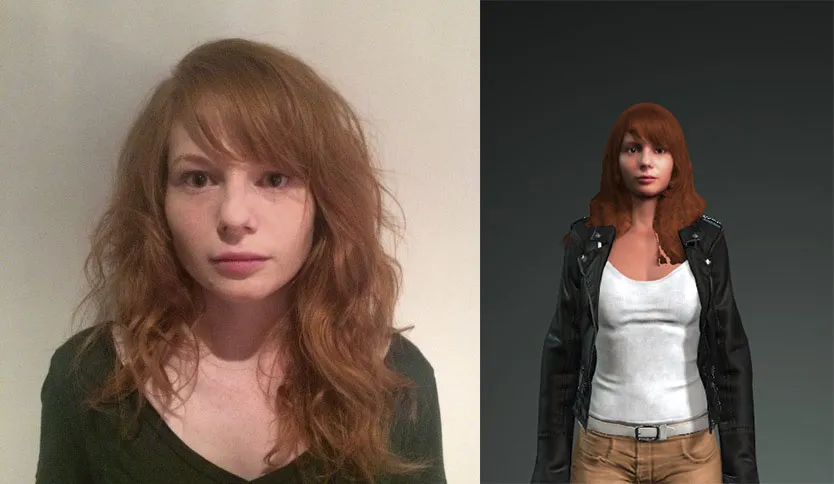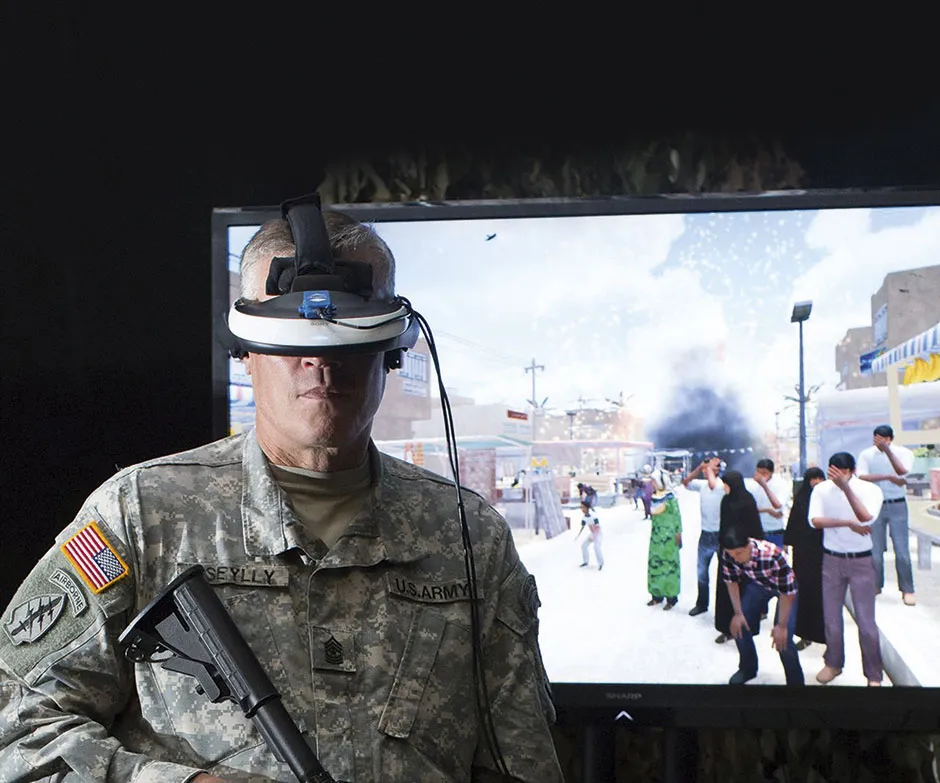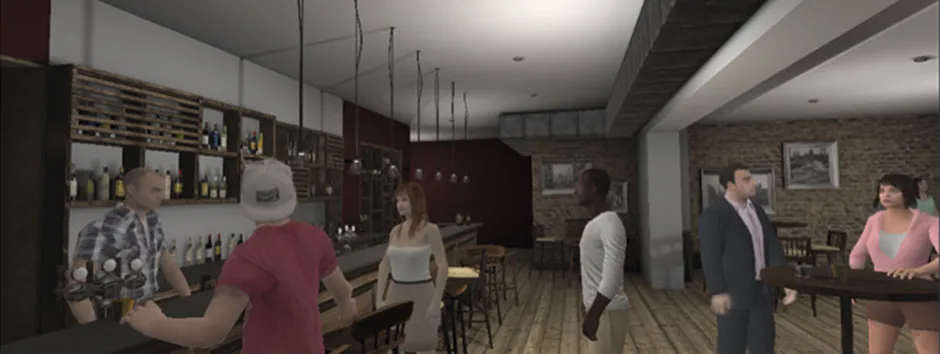Do you ever have days when you can’t seem to do anything right? Days when you’re fed up with yourself? Days when you berate yourself for things you’ve said or done with the sort of angry monologue that you wouldn’t subject a friend to? From time to time, we all do.
But while it’s common to sometimes struggle to be kind to ourselves, for some people, especially those with depression, relentlessly picking at their own worst traits can become an endless cycle of self-bullying.
Therapy seeks to break that cycle through various approaches and one of the newest involves virtual reality (VR). At University College London, Prof John King and Dr Emma Jayne Kilford are working on a VR intervention to use as an adjunct to face-to-face therapy for depression. They hope the new therapeutic angle VR provides can help people increase their ability for self-compassion.
Their system uses a virtual room in which there are two avatars: a child and an adult. Before participants enter the room, they’re trained in how to use a compassionate script to lift the mood of someone who’s distressed. There are three parts to the script: validating experience, redirecting attention and activating a positive memory.
As the participant enters the virtual room they’re confronted with the distressed virtual child and their task is to comfort the child using the script until its distress lessens.

The next time the participant enters the room, they’re the child and they get to see their adult avatar (themselves from the previous session) performing the compassionate script.
“They sit there as a child,” explains King, “and they literally have the experience of compassion. It’s a form of very souped-up imagery.” The adult avatar can even be made to look like the participant, although not all of them opt for this.
Initial results in one sample of self-critical students and another of people experiencing depression show significant reductions in measures of self-criticism and depression, as well as improvements in self-compassion. A larger trial has begun, with hopes that the intervention will become an option for people undergoing treatment for depression.
Read more of the ideas you need to know in 2021:
- The cracks in cosmology: Why our Universe doesn't add up
- Rewilding: Can it save our wildlife and temper climate change?
- How swarm spacecraft could help us understand Earth like never before
- Addiction, crime and data breaches: The metaverse could become a wild west if we’re not careful
VR therapy and phobias
This is just one of many VR interventions for mental health problems that are currently in development or already in the clinic. VR in mental health treatment has been around since the mid-1990s, but recent advances in headset capabilities and reductions in cost have made it more feasible and accessible, and research in VR-assisted therapy is booming.
The most-established use of VR-assisted therapy is for anxiety disorders. For simple phobias where someone has one predominant fear, VR can be used to expose the person to that fear gradually and safely.
“I was plagued with a fear of heights for years,” says Judith Keeling, who heard about a research trial into VR therapy for height phobia in her hometown of Oxford and decided to try it. “I was intrigued, but dubious.”
Judith remembers the experience: “You put the [headset] on and you find yourself in the atrium of a shopping mall. You can choose what floor you start at, then you go to that floor in a lift. [The doors open, you walk out] and there’s a glass barrier between you and the drop, as if you’re looking down into the atrium. And then the barrier is removed. I jumped back when that happened.”

Even though Judith knew it wasn’t real and she found the VR setting somewhat cartoony, she still felt as if she was up high. For Daniel Freeman, a professor of clinical psychology at the University of Oxford, that’s no surprise.
“Whatever the computer shows you, that’s your reality… The beautiful bit of the therapy is that there’s also a conscious bit of your brain saying it’s not real, therefore I can try things differently. It doesn’t break the spell; it just enables you to make the learning.”
In this intervention, people complete increasingly tricky tasks on each floor until they reach the top floor, where there’s a wobbly bridge to walk across, which they can see through. If they accomplish that, they get to ride on the back of a surreal blue whale that’s been floating around inside the shopping mall. “It feels unreal,” says Judith. “So although I was uncertain, I could make myself do it.”
After three sessions Judith wasn’t sure whether the treatment had done much, but she noticed the difference when she went on a once-in-a-lifetime family holiday. “I was at Angkor Wat, in Cambodia, where there are a lot of rickety outdoor ladders and I was walking up and down them without any problems.”
Immersive therapy
Freeman sees a key role for VR in automating some aspects of therapy to improve access. “There are some very powerful psychological therapies, but far too few people get them,” he says.
Freeman also thinks VR therapy can be more powerful than traditional therapy. “You can do things you can’t do in face-to-face therapy… The ultimate aim is using the tech not just to replicate successful therapies… but to push them even further.”
One example of pushing the therapy further is in the treatment of post-traumatic stress disorder (PTSD). PTSD involves a trio of symptoms: hyperarousal (feeling extra anxious to threat), avoidance (not wanting to think or talk about traumatic memories) and re-experiencing symptoms, such as intrusive images, nightmares or flashbacks.
PTSD is common in war veterans and a VR package called Bravemind has been designed specifically for soldiers who served in Afghanistan by Dr Albert ‘Skip’ Rizzo at the University of Southern California. “We use the best technology to train soldiers for war; we should use the best technology to fix the… mess afterwards,” he says.

Bravemind simulates war situations using 14 customisable virtual worlds. A therapist controls what happens, tailoring content to the memories of the person reliving the trauma, allowing those memories to be processed and the re-experiencing of symptoms to resolve.
The principles are identical to traditional cognitive behavioural therapy for PTSD, so the treatment still needs a therapist but the imagery is more immersive. “It’s a real-time clinical tool,” says Rizzo. “Technology doesn’t fix anyone; it extends the skills of a well-trained clinician.”
When Bravemind is used in conjunction with a trained therapist, its results are equivalent to, or better than, traditional therapy. A small fMRI study showed changes in the brain areas associated with PTSD too.
A safe environment
It’s not only depression and anxiety that can benefit from VR therapy. At the Institute of Psychiatry, Psychology & Neuroscience (IOPPN) at King’s College London, Dr Lucia Valmaggia and her colleagues are working with individuals who experience psychosis, which is characterised by a loss of contact with reality that often involves hearing or seeing things that others can’t, strong feelings of paranoia or delusional thoughts. VR can simulate situations where paranoia might be problematic.
“We use the VR as a first experience of something,” Valmaggia explains. “For example, someone walks into a VR pub and the first thing they do is tense up when someone says hello. You see if they’re aware or not that they’re doing it. You teach them to breathe, to become aware of their jaw, to do all of that. And then they try it. Not straightaway in a real pub, but in a VR situation around other people.
“The person experiencing it knows that it’s not real so they’ll try to do more things and they’re more able to get new experiences and physiologically new responses,” she says. “It’s a trick to have experimental control in an ecologically valid environment and, at the same time, [for] the person experiencing it to be able to try something new.”

Jemma* has tried the intervention. Diagnosed with psychosis in 2019, Jemma has a background in video game experience design and her psychotic experiences left her feeling convinced that she was living inside a game. As these beliefs subsided, Jemma found she became uneasy in social situations and was uncomfortable being seen by others.
“I had a visceral reaction to [the VR therapy]. It was kind of amazing,” says Jemma, who froze as she went into the virtual pub, due to feeling intense fear. “I just totally shut down and couldn’t say anything… There’s no hiding from it… It’s very honest and transparent.”
With practice and therapeutic support, Jemma overcame her fear and became more comfortable and confident. She was also recommended a relaxation programme available on YouTube that lets her swim with dolphins in a virtual sea by using a cardboard VR headset into which she slots her mobile phone. “It’s very relaxing,” she says.
Coming to a clinic near you?
VR therapy is not without its challenges. While the headsets are vastly cheaper than they once were, accessibility still depends on clinics being able to purchase them for patient use. There’s also a strong need to understand the ethical complexities around digital security to ensure sensitive data can’t be harvested. “I do see that as being a critical issue,” cautions Kilford. “The tech always moves so much faster than the regulatory body.”
The inevitable lag between technological progress and good-quality research means studies can be out of sync with the technology by the time they’re completed. Plus, VR only works for certain types of talking therapy (usually those belonging to cognitive behavioural schools).
Read more about VR therapy:
- Confronting trauma with virtual reality therapy
- How virtual reality is used in treating anxiety disorders
- How VR could break America's opioid addiction
Nevertheless, the tech and research advances mean VR therapy is finally coming of age. Rizzo thinks we’re not far off the day when “headsets in the home will be like toasters. You know, you don’t use it everyday, but every home has one… It’ll get to a point where every clinician has a VR headset in their drawer and they’ll have had some training [on how to incorporate its use into therapy] at some point.” Rizzo also thinks 5G will help clinicians access VR interventions.
The variety of VR-assisted therapies being researched covers a huge range of disorders and settings. There are VR kitchens to help people with eating disorders, relaxation programmes for people in inpatient care, and programmes for schoolchildren to help them handle their assumptions of what others think of them (especially helpful for children who’ve been bullied or had experiences that can affect future relationships). Whatever you can imagine a use of VR for, it can be programmed.
VR therapy won’t replace human therapists, but it’s a powerful adjunct and access to it is going to grow. VR therapy for fear of heights is already available in a number of UK NHS Improving Access to Psychological Therapy clinics, and several of the VR research trials are available in NHS Trusts too.
As VR therapy grows, it’ll be key that the programmes we choose are ones with established efficacy, and are co-designed by clinicians and people with experience of mental health problems. And there is no shortage of those to choose from.
*Jemma has requested that only her first name be used.
- This article first appeared inissue 358ofBBC Science Focus Magazine–find out how to subscribe here
